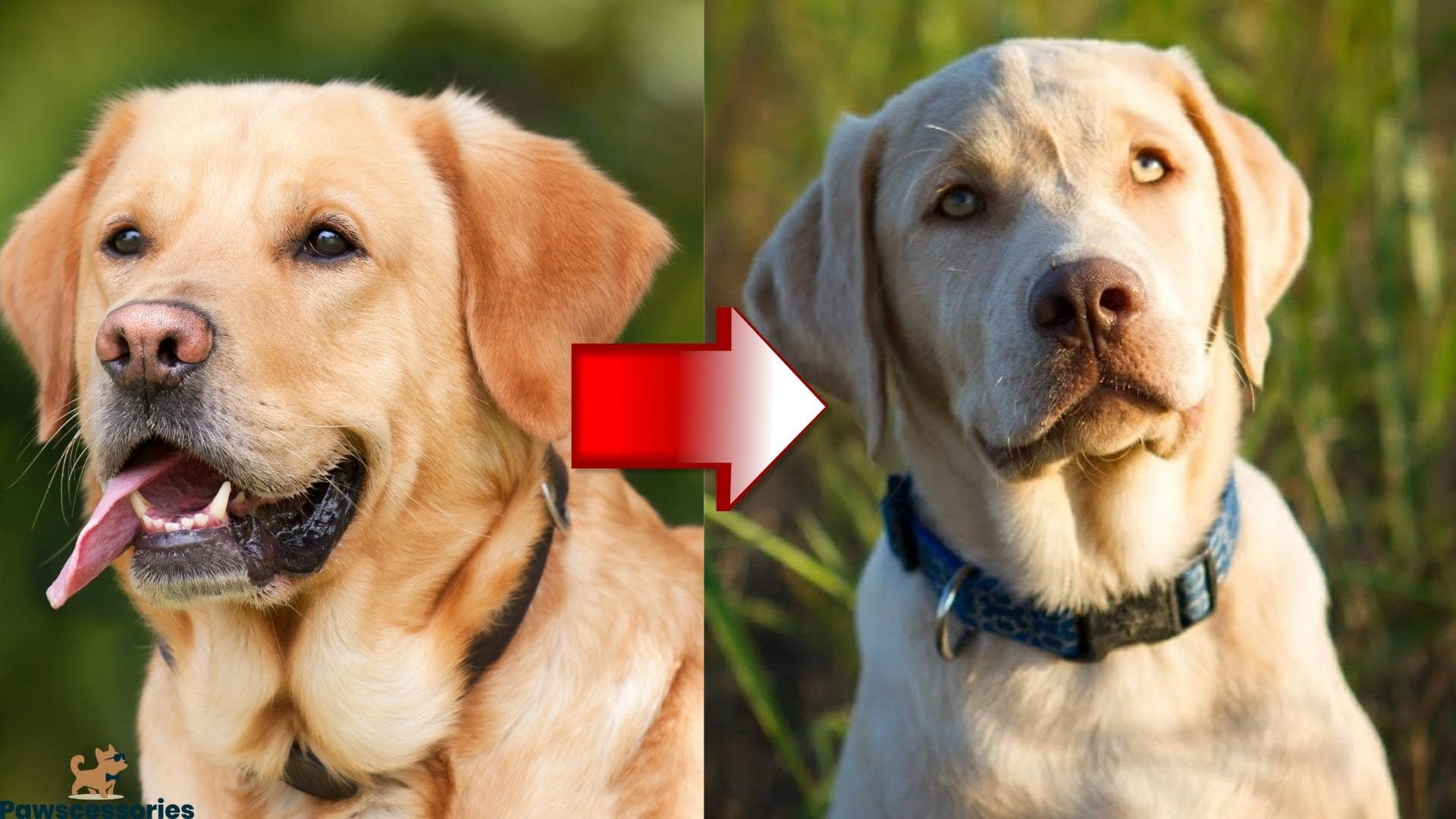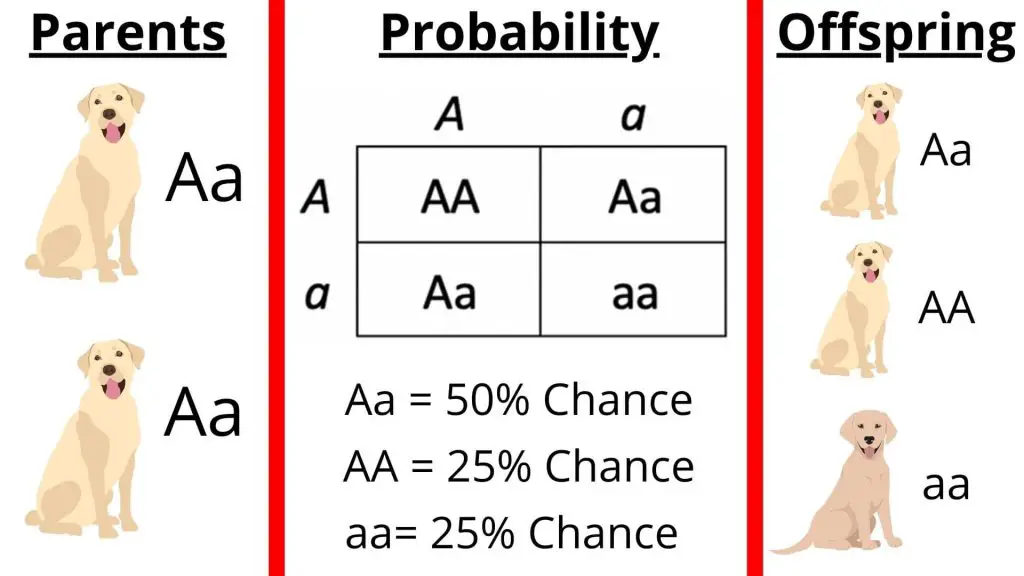Pawscessories is reader-supported. When you buy via links on our site, we may earn an affiliate commission at no cost to you.
Learn more.
The Labrador Retrievers are among the most popular breeds in the world. Champagne Lab is a term used to describe a specific color variation of the Labrador Retriever.
This unique coloration has become increasingly popular in recent years, but there is still a lot of mystery surrounding them.
What caused the Champagne Labrador’s distinctive coloration? What’s the difference between the Champagne Lab and other color Labs?
In this post, I will explore the history and origins of the Champagne Lab. I will also discuss comparisons with other Lab colors, the price, size, personality, and other unique facts about them.
Let’s dive in.
Table of Contents

What Is A Champagne Labrador?
The Champagne Lab is a light-colored variation of the Labrador Retriever breed. They are often mistaken for being albino, but this is not the case. Albino Labs do exist, but they are incredibly rare and have a completely different set of genetic traits.
Campagne Labs have a pale yellow coat, but it can range in color from very light gold to a more reddish hue. Champagne Lab puppies are born with pale yellow fur, but it darkens as they age.
This coat color is referred to as a “dilute” color. Some other dilute colors of Labs are silver and charcoal Labs.
How Does A Champagne Labrador Come To Be?
The Champagne Lab is not a separate breed of dog but a color variation of the Labrador Retriever.
There seems to be a debate among people whether or not the Champagne coat is naturally occurring in Labradors or if it’s a result of cross-breeding.
The commonly accused breed thought to be responsible for this gene is the Weimaraner.
Regardless of how the gene developed, the Champagne coat color is caused by this recessive gene. This means that for a Champagne Lab puppy to be born, both parents must carry the recessive genes.
If only one parent carries the gene, the puppy will not be Champagne-colored. However, they will be carriers of the Champagne gene and can pass it on to their offspring.
The Champagne Coat Color Genetics
Genes are responsible for the color of a Champagne Lab’s coat. Genes are made up of pairs of alleles.
When dogs mate, the offspring receives one allele from mom and one from dad. These alleles then form to make up their genes.
To simplify, If “Aa” is a gene, then “A” and “a” would be the alleles. So, depending on which gene (Aa, AA, or aa) the parents have will affect which coat color their offspring will have and the probability of getting specific colors.
Here is a simple example with some visuals to help:
- AA is the gene of a yellow Labrador
- Aa is the gene of a yellow Labrador
- aa is the gene of a Champagne Labrador
Let’s say two yellow Labs breed, and each has the gene “Aa.” This would give the offspring a 25% chance of being a Champagne Labrador and a 75% chance of being a yellow Lab.

In this example, the “aa” gene represents the dilute gene responsible for creating the Champagne color in Labs. So, for a Lab to have this coat, their parents must have a part of this gene.
*Note: This is just a simplified version of dog genetics to help better understand.
Are Champagne Labs Rare?
While Champagne Labs are not as rare as some other colors like silver Labs, they are still considered rare.
As I mentioned, for a Champagne Lab puppy to be born, both parents must carry the recessive gene.
And even if both parents have the gene, it’s still not guaranteed Champagne Labrador puppies will be born.
Therefore, the probability of a Champagne Labrador being born is low.
Champagne Vs. Yellow Lab: What’s The Difference?

The Champagne color is often mistaken for being a light yellow. Still, there is actually a big difference between the two colors.
In addition, the Champagne Labs also have a few unique characteristics that set them apart.
Let’s compare and contrast:
- Champagne Labs have a pale yellow coat with hues of gold or red. They are born with very pale fur, but it darkens as they age. Yellow Labs have a solid, rich coat of yellow.
- Yellow Labs usually have dark brown eyes, while Champagne Labs have slightly lighter eyes.
- The Champagne Labrador is considered rare, while yellow Labs are not.
- The Yellow Lab usually has a darker tone nose. Since the Champagne Labs have a dilute gene, this can translate into other physical features being lighter colored.
- The Champagne Labradors color is not classified by the AKC as its own color. They are considered yellow Labs by many professionals.
- Due to the bright glimmer of the Champagne Lab coat color, they tend to overheat quicker than Yellow Labs.
- Some of the Champagne Labs may have other breeds in their genetics. However, If you get them from a reputable breeder, you can find this out before purchasing a puppy.
Champagne Lab Breed Information
Now that we know a little more about the Champagne Lab, let’s dive into some common character traits of this breed.
Champagne Lab Appearance & Build

A Champagne Lab is the same build as a regular Labrador Retriever. They are strong and sturdy dogs with muscular frames.
Their eyes are lighter than regular Labs and have a long tail. Champagne Labs also have webbed toes, which makes them great swimmers.
A Champagne Lab can have a variety of yellow shades. Their coat is usually a pale yellow, but it can also be a light gold or even have hues of red.
How Big Is A Champagne Lab?
Males Champagne Labs typically weigh between 65-80 pounds and females 55-70 pounds.
Their height also corresponds with their weight, males averaging 21.50-24.50 inches and females 20.50-22.50 inches.
Champagne Labradors Temperament & Trainability
Like regular Labs, Champagne Labs are known to be friendly, outgoing, and high-spirited. They love being around people and other animals.
This breed is very intelligent, which makes them easy to train. They are also eager to please their owners, which is another plus when it comes to teaching them.
Champagne Labs have a lot of energy and need to be active. They love to play fetch, go for long walks, and swim. Therefore, they must be exercised for at least an hour daily.
If Champagne Labs don’t get enough exercise, they can become bored, leading to them getting into mischief.
Overall, Champagne Labs make great family pets and are good with children. They are gentle and loving but also have a silly side that will keep you entertained.
Shedding & Grooming

The Champagne Lab is an average shedder and requires regular grooming.
Since they have a water-resistant coat, they love to swim and play in the water, which can make them smell bad. This is why it’s important to give them baths and brush their coats regularly.
Their nails also grow quickly, so you will need to trim them every few weeks.
Many parents opt to get a robot vacuum to help them stay on top of all their shedding.
Also, it’s recommended to blow out their coat during seasonal shedding times (generally spring and fall).
You can use a dog blow dryer to help get rid of a large amount of their dead or loose fur before it finds its way all over your house.
Lifespan
The average lifespan of a Champagne Lab is between 10-12 years.
This is the same as a regular yellow Lab.
However, due to the dilute gene that causes their coloration, Champagne Labs may be prone to more health issues.
Common Health Issues

Some of the Champagne Labradors’ common health problems include:
Color Dilution Alopecia
This is a skin condition that Champagne Labs are more susceptible to due to the dilute gene. It causes the dog to lose patches of fur and can lead to balding.
Hair loss may begin between 4 to 18 months of age. In addition, Champagne Labs’ skin can become scaly or have a crusty appearance.
This is a treatable condition, and many Champagne Labs live normal, happy lives despite having it.
However, there is no cure for this condition.
Joint Problems
Champagne Labs are prone to joint issues such as hip and elbow dysplasia.
This is because they are a larger breed of dog.
Joint problems can cause your Champagne Lab pain and make it difficult for them to move around.
Hip and elbow dysplasia, degenerative joint disease, and osteochondrosis are all common joint issues in Champagne Labs.
These problems can be managed with medication and a special diet. It’s essential to catch them early so your dog doesn’t experience too much pain.
Bloat
Bloat is a condition that Champagne Labs are more susceptible to due to their deep chests.
It occurs when the stomach fills with gas and twists. This can cut off blood flow and cause the dog to go into shock.
Bloat is a medical emergency and can be fatal if not treated quickly.
Cancer
Cancer is the leading cause of death in Champagne Labs.
Lymphoma, hemangiosarcoma, and mast cell tumors are all common types of cancer that Champagne Labs can get.
Many of these cancers are treatable if caught early. That’s why it’s important to take your Champagne Lab to the vet for regular check-ups.
Obesity
Obesity is a common health problem in Champagne Labs.
This is mostly because they love to eat and will overeat when given the chance.
Obesity can lead to joint problems, diabetes, and even cancer.
It’s important to feed your Champagne Lab a healthy diet and make sure they get plenty of exercise.
Progressive retinal atrophy
Progressive retinal atrophy is an eye condition that causes the dog to slowly lose vision and can eventually lead to blindness.
Food & Diet

The Champagne Lab is a large breed of dog and therefore requires a lot of food.
They should be fed twice a day, once in the morning and once at night.
A good quality dry dog food is the best option for Champagne Labs. Make sure to get food that is specifically made for large breed dogs.
The food type will depend on the dog’s age, size, and activity level.
As always, make sure to speak with your vet about what kind of protein, treats, etc., are the best for your individual dog.
My father, Dr. Littlejohn, and our head veterinary consultant recommends these four brands above all else:
What Is The Price Of A Champagne Lab?

Champagne puppies usually cost between $1000 to $2000.
The price will depend on the breeder, the parents’ pedigree, and if the puppy has any unique markings.
These puppies usually cost a little more than your average Labrador since they are rare.
Some Champagne Labs may even have a higher price tag, closer to $3000.
However, always ensure you get your Champagne Labrador puppy from a reputable breeder.
There are a lot of backyard breeders who want to make a fast profit by selling sick or unhealthy dogs.
Where Can You Buy A Champagne Lab?

Here are a few places you can check for Champagne Labradors:
- https://puppyfinder.com/
- https://puppies.com/
- https://www.keystonepuppies.com/
- https://marketplace.akc.org/puppies
Another way to get Champagne Labs is to go through a rescue organization to adopt. It might not be a purebred Lab, but it will likely have some of the same traits.
In addition, adopting a dog is often cheaper than buying a puppy, and you’ll be giving a dog in need a home.
Several alternatives exist; please conduct your own study before purchasing or adopting a Champagne Lab.
Other Frequently Asked Questions
What Color Of Lab Is The Rarest?
The rarest color Lab is the silver Labrador. Silver is the rarest color because the parent Labs must carrier the double recessive dilute gene. This is the only way a silver Labrador can be bred.
Do Champagne Labs Have Pink Noses?
Technically yes, Champagne Labs will have pink noses when they are born. This goes for all Labs. However, most Champagne Lab noses will turn brown or black after the first few weeks of their lives.
Some Champagne Labs end up with slightly lighter noses than a regular Yellow Lab.
What Color Of Lab Is The Smartest?
There is no “smartest” Color Lab. A dog’s intelligence is not determined mostly by how they were bred. Coat color plays no factor in a dog’s intelligence.
All colors of Labs can be of equal intelligence and trainability. To get the smartest Lab possible, find a reputable breeder who can give you some information on the parent dogs.
If both parent dogs were brilliant, their puppies would likely be too.
Final Thoughts
There you have it, everything you need to know about the Champagne Labrador!
Dilute Labradors have unique and rare colors that are becoming more and more popular as people learn about them. If you’re thinking of getting a Champagne Lab, make sure you do your research so you can find a reputable breeder.
And always remember, no matter what color your Lab is, they’re still one of the best dogs around!
Other posts you might find interesting:
10 Best Dog Beds for Labs: An In-Depth Feature Review
